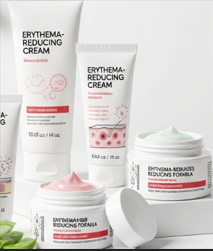Treatment Overview
Erythema-reducing creams are a frontline topical therapy in Korea for patients with redness, flushing, and vascular sensitivity, especially related to rosacea, post-inflammatory erythema, and sensitive skin syndromes. These creams often include vasoconstrictors (brimonidine, oxymetazoline), anti-inflammatory agents (metronidazole, ivermectin), and soothing botanicals (Centella asiatica, panthenol, madecassoside) that target both vascular reactivity and skin barrier imbalance.
Korean dermatology clinics prescribe or recommend these creams as part of a layered redness program, often combining them with lasers, cooling therapies, and oral medications for comprehensive results. They are valued for providing visible redness reduction within minutes to weeks, depending on the active ingredient.
For redness and flushing, Erythema-Reducing Cream Therapy:
- Provides immediate or gradual redness reduction.
- Calms inflamed skin and reduces vascular sensitivity.
- Strengthens skin barrier against future flare-ups.
- Works as a long-term maintenance option for sensitive or rosacea-prone skin.
Purpose & Benefits
- Vasoconstriction: Brimonidine and oxymetazoline constrict superficial vessels for quick redness relief.
- Anti-Inflammatory Action: Metronidazole and ivermectin reduce rosacea inflammation.
- Barrier Repair: Korean creams often include Centella, madecassoside, or panthenol.
- Non-Invasive: Topical option for patients who cannot take systemic therapies.
- Combination-Friendly: Enhances results when paired with lasers or systemic care.
Ideal Candidates
Erythema-Reducing Creams in Korea are recommended for:
- Patients with rosacea-related redness and flushing.
- Individuals with post-acne erythema or vascular scarring.
- Adults with sensitive, reactive skin who need a gentle daily solution.
- Patients preparing for or maintaining results after laser therapy.
- Those preferring non-systemic treatments for vascular redness.
Comparison with Other Treatments
- Erythema-Reducing Creams (Brimonidine, Metronidazole, Centella-based): Daily topical redness control; short- and long-term benefits.
- Anti-Redness Lasers (PDL, V-Beam, Nd:YAG): Most effective for permanent vessel reduction.
- Antibiotics (Doxycycline, Minocycline): Systemic anti-inflammatory; long-term vascular stability.
- Beta-Blockers (Propranolol, Carvedilol): Target adrenaline-driven flushing; systemic effect.
- Chemical Peels (Gentle Korean-style): Reduce post-acne erythema, mild redness effect.
- Cooling Masks: Provide immediate calming and hydration; short-term soothing.
Possible Risks & Complications
Erythema-reducing creams are safe, but may cause:
- Temporary skin dryness or tightness.
- Rebound redness (particularly with overuse of vasoconstrictors).
- Mild irritation or contact dermatitis in sensitive individuals.
- Gradual reduced effectiveness if used long-term without breaks.
Treatment Techniques Used
- Prescription Creams: Brimonidine gel, oxymetazoline cream, or metronidazole/ivermectin.
- Cosmeceutical Creams: Centella, madecassoside, or panthenol-based formulas from Korean skincare lines.
- Application: Applied once or twice daily, depending on dermatologist instructions.
- Combination Therapy: Often paired with anti-redness lasers or systemic medications.
- Clinic Integration: Dermatologists may recommend specific clinic-formulated creams for post-laser care.
Recovery & Aftercare
- Immediately After Use: Brimonidine/oxymetazoline can visibly reduce redness within 30 minutes.
- 2–4 Weeks: Anti-inflammatory creams (metronidazole, ivermectin) reduce baseline redness.
- Maintenance: Daily use supports skin barrier and prevents relapses.
Aftercare Tips:
- Use sunscreen daily to prevent vascular flare-ups.
- Avoid layering with harsh exfoliants or retinoids unless instructed.
- Pair with gentle cleansers and hydrating serums.
- Monitor skin response and adjust frequency if irritation occurs.
Results & Longevity
- Short-Term (Immediate–1 Day): Rapid redness reduction with vasoconstrictor creams.
- Medium-Term (2–4 Weeks): Calmer skin tone, reduced flushing frequency.
- Long-Term: Stable redness control when combined with lasers or systemic therapy.
Treatment Process in Korea
- Consultation & Diagnosis – Dermatologist evaluates redness cause (rosacea, post-acne, vascular).
- Prescription or Recommendation – Cream chosen (prescription vs. medical-grade cosmeceutical).
- Usage Instruction – Application guidelines tailored to skin type and sensitivity.
- Clinic Add-Ons – Post-laser redness protocols often include medical cooling masks + erythema-reducing creams.
- Follow-Up – Results monitored; cream use adjusted for long-term control.
Why Korea is a Top Destination
- Wide range of prescription and over-the-counter redness creams available.
- Dermatologists customize topical regimens with laser and infusion programs.
- Affordable compared to Western prescriptions and cosmeceuticals.
- Strong emphasis on barrier repair and sensitive-skin formulations.
- Korea is a leader in Centella and madecassoside-based creams for vascular skin concerns.
Cost Range (Detailed Breakdown)
Pricing for Erythema-Reducing Creams in Korea for redness & flushing:
- Prescription Creams (Brimonidine, Oxymetazoline, Metronidazole, Ivermectin): USD 20 – 50.
- Medical-Grade Clinic Creams (Barrier + Soothing): USD 30 – 80.
- Consultation Fee: USD 20 – 40.
- Clinic Package (Laser + Cream + Cooling Aftercare): USD 300 – 800 (3–5 sessions).
- Premium Redness Care Program (Lasers + Creams + Barrier Infusions): USD 700 – 1,500.
Additional Costs in Korea:
- Sunscreens for sensitive/redness-prone skin: USD 20 – 50.
- Barrier serums or soothing ampoules: USD 30 – 90.
💡 Patients often call these creams the “daily redness shield”, since they provide both immediate and long-term protection against vascular sensitivity.
Popular Clinics in Seoul
- Oracle Dermatology – Prescribes brimonidine/oxymetazoline creams with V-Beam care.
- Banobagi Dermatology – Combines medical-grade redness creams with barrier infusions.
- Renewme Skin Clinic – Topical metronidazole/ivermectin with laser therapy for rosacea.
- View Plastic & Dermatology – Daily redness creams integrated into flushing control programs.
- Chaum Anti-Aging Center – Premium redness programs with topical + systemic + laser integration.




